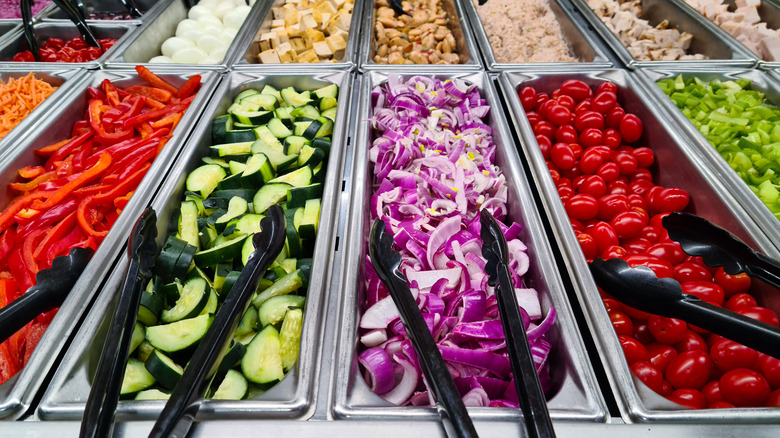The Salad Bar At A Grocery Store May Feature Older Produce. Here's Why
When it comes to fruits and vegetables, you've probably heard the saying Fresh is Best. Almost every healthy meal plan recommends eating more produce, and farm-fresh picks are probably what comes to mind. But it can be a challenge to your time and sanity to cook fresh produce at every meal. How can you get your recommended five servings of fruits and vegetables a day if you don't have time to wash, cut, and peel them?
Enter the grocery store salad bar. It's a convenient, cost-effective way to purchase exactly the fresh veggies you need (not to mention a quick lunch). No prep, no clean-up, no waste. Options on a typical salad bar can vary from standard veggies like lettuce, tomato, and cucumber to more filling fare like egg salad, chicken salad, or even rotisserie chicken. For many shoppers, the salad bar is a meal prep inspiration.
So what's the downside? Well, the salad bar's convenience comes at a cost — to quality, and maybe peace of mind.
Where the old produce goes
When the fruits and vegetables in the produce aisle start looking less than fresh, there's pressure on the store to avoid waste and maintain profit. According to Forbes, one of the easiest ways to use up that wrinkly produce is to stock their on-site salad bar. That bruised tomato, sprouting onion, or wilted spinach can look farm-fresh after a quick peel and chop. And usually, the customer never knows the difference.
Taste of Home reports more fragile fare like avocados and peaches last less than five days uncut before quality visibly suffers. Hardier options like garlic and onions can hit the three month mark before showing their age. All of this means that your produce could be weeks or even months past its pick date by the time it lands on the salad bar where, according to the FDA, leafy greens can then stay up to seven days after being cut.
Unfortunately, grocery store produce is already dirty, so when that much-handled produce is chopped and added to the open-air salad bar, it could be compounding the problem of quality and cleanliness. And it's not just the veggies to watch out for. Additional toppings like feta cheese or crispy croutons can lose quality when they're left exposed to open air.
The future of the salad bar
But don't abandon your healthy goals yet! Now the future of fresh, clean eating is brighter than ever — even at the salad bar.
Advances in retail technology are changing the landscape of the grocery store salad bar to improve quality and safety. The St. Louis Post Dispatch explains that newer salad bar equipment can now adjust the temperature, maintain humidity, and even use artificial intelligence to replenish ingredients. Food service companies are even offering innovative "touchless" buffet bars for salad buffs that bypass the need for multiple-user serving utensils.
All these new technologies are aimed at improving safety while maintaining the freshness of ingredients. That means a healthier eating experience that allows you to enjoy your next salad instead of questioning its quality.
It's true that produce loses some of its nutritional value soon after being picked. However, eating more veggies in whatever form you can get them is crucial to good health. So if the salad bar gets more veggies on your plate, then grab your fork and take a bite!


